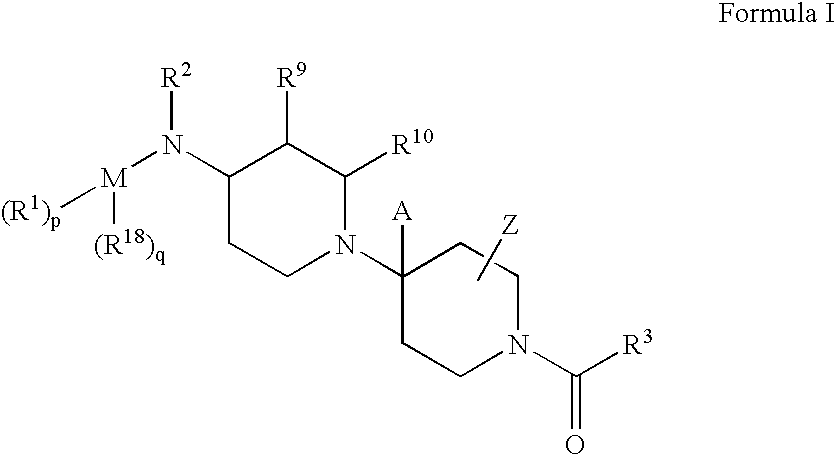Bipiperidinyl derivatives useful as inhibitors of chemokine receptors
a technology of chemokine receptors and derivatives, which is applied in the direction of biocide, drug composition, immunological disorders, etc., can solve problems such as multi-drug resistance, and achieve the effect of preventing or improving one or mor
- Summary
- Abstract
- Description
- Claims
- Application Information
AI Technical Summary
Benefits of technology
Problems solved by technology
Method used
Image
Examples
example 1
[0192]
Step 1
[0193] To a solution of 4-nitrobenzyl amine hydrochloride 1 (7.5 g, 40 mmol) in 1:1 EtOAc / H2O (120 mL) was added K2CO3 (16.5 g, 119 mmol) and allyl chloroformate (5.07 mL, 47.8 mmol). The resultant biphasic solution was stirred vigorously at room temperature for 16 hours. The aqueous layer was extracted with EtOAc (3×). The combined organic layers were washed with brine, dried over Na2SO4, filtered and concentrated to afford 15.3 g of the crude product which was used without further purification.
Step 2
[0194] To a slurry of copper(II) acetylacetonate (2.54 g, 9.7 mmol) in EtOH (70 mL) at 0° C. was slowly added sodium borohydride (4.71 g, 124.4 mmol). The resultant slurry was stirred at 0° C. for 30 min. A slurry of the nitro compound from step 1 (9.2 g, 38.9 mmol) in EtOH (70 mL) was added and the resultant solution was stirred at 0° C. and allowed to slowly warm to room temperature over 16 hours. Water (20 mL) was slowly added to the solution. The solution was then ...
example 2
[0202]
Step 1
[0203] To a solution of amine 8 (140 mg, 0.27 mmol) in CH2Cl2 (2 mL) at 0° C. was added Et3N (0.036 mL, 0.27 mmol) and 4-chlorobutyryl chloride (0.030 mL, 0.27 mmol). The solution was allowed to stir at 0° C. for 30 min. then an additional 1 hour at room temp. The solution was diluted with CH2Cl2 and washed with NaHCO3, dried over Na2SO4, filtered and concentrated. The crude product was redissolved in dry THF (2 mL). To this solution NaH (22 mg, 0.56 mmol) was added and the solution was heated to reflux for 6 hours. The solution was cooled to room temperature and water was slowly added. The aqueous layer was extracted with EtOAc (3×). The combined organic layers were washed with brine, dried over Na2SO4, filtered and concentrated. The crude product was purified by prep TLC (1:1 Acetone / hexanes) to afford 32 mg as a white foam (20%). The HCl salt of this product was formed by the addition of 4N HCl (dioxane) followed by evaporation. HRMS calc for C36H47N6O2(MH+): 595.37...
example 3
[0204]
Step 1
[0205] To a solution of ethyl (S)-mandelate (10.0 g, 55 mmol) in CH2Cl2 (300 mL) was added DMAP (670 mg, 5.5 mmol), acetic anhydride (5.77 mL, 61 mmol) and iPr2NEt (10.6 mL, 61 mmol). The solution was stirred at room temperature for 16 hours. The solution was diluted with CH2Cl2 and washed with NH4Cl (aq.). The organic layer was dried over Na2SO4, filtered and concentrated to afford 12.0 g as a clear oil. The product was used without further purification.
Step 2
[0206] To a solution of the arene from Step 1 (12 g, 54.1 mmol) in acetic anhydride (65 mL) at 0° C. was added dropwise a mixture of nitric acid (13 mL) and sulfuric acid (15 mL). The solution was stirred at 0° C. for 4 hours. The solution was slowly poured into water and extracted with EtOAc. The organic layer was washed with sat. NaHCO3 and brine. The organic layer was dried over Na2SO4, filtered and concentrated. The crude product was purified by flash chromatography (gradient 100:0 to 7:3 hex / EtOAc) to aff...
PUM
| Property | Measurement | Unit |
|---|---|---|
| temperature | aaaaa | aaaaa |
| pH | aaaaa | aaaaa |
| temperature | aaaaa | aaaaa |
Abstract
Description
Claims
Application Information
 Login to View More
Login to View More - R&D
- Intellectual Property
- Life Sciences
- Materials
- Tech Scout
- Unparalleled Data Quality
- Higher Quality Content
- 60% Fewer Hallucinations
Browse by: Latest US Patents, China's latest patents, Technical Efficacy Thesaurus, Application Domain, Technology Topic, Popular Technical Reports.
© 2025 PatSnap. All rights reserved.Legal|Privacy policy|Modern Slavery Act Transparency Statement|Sitemap|About US| Contact US: help@patsnap.com



